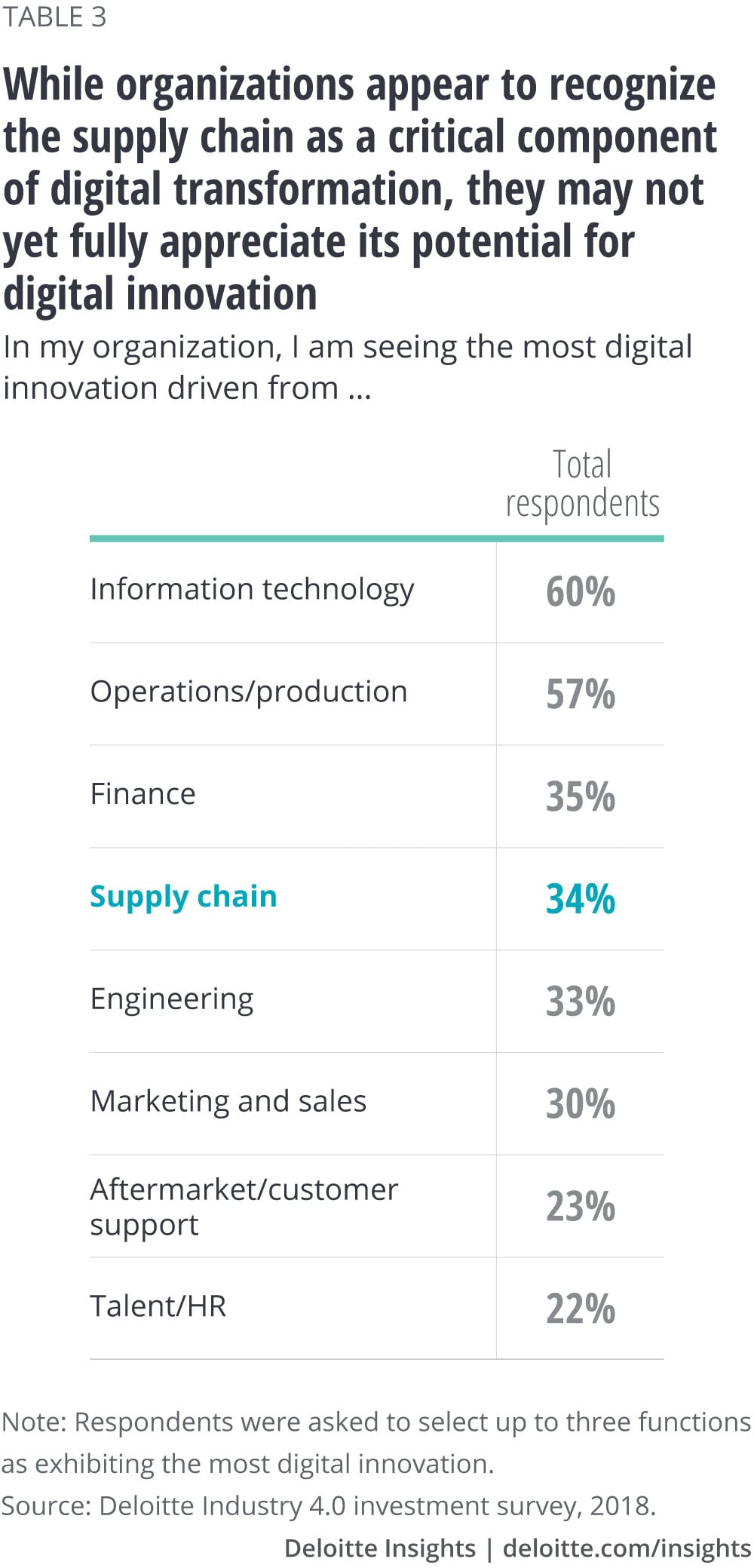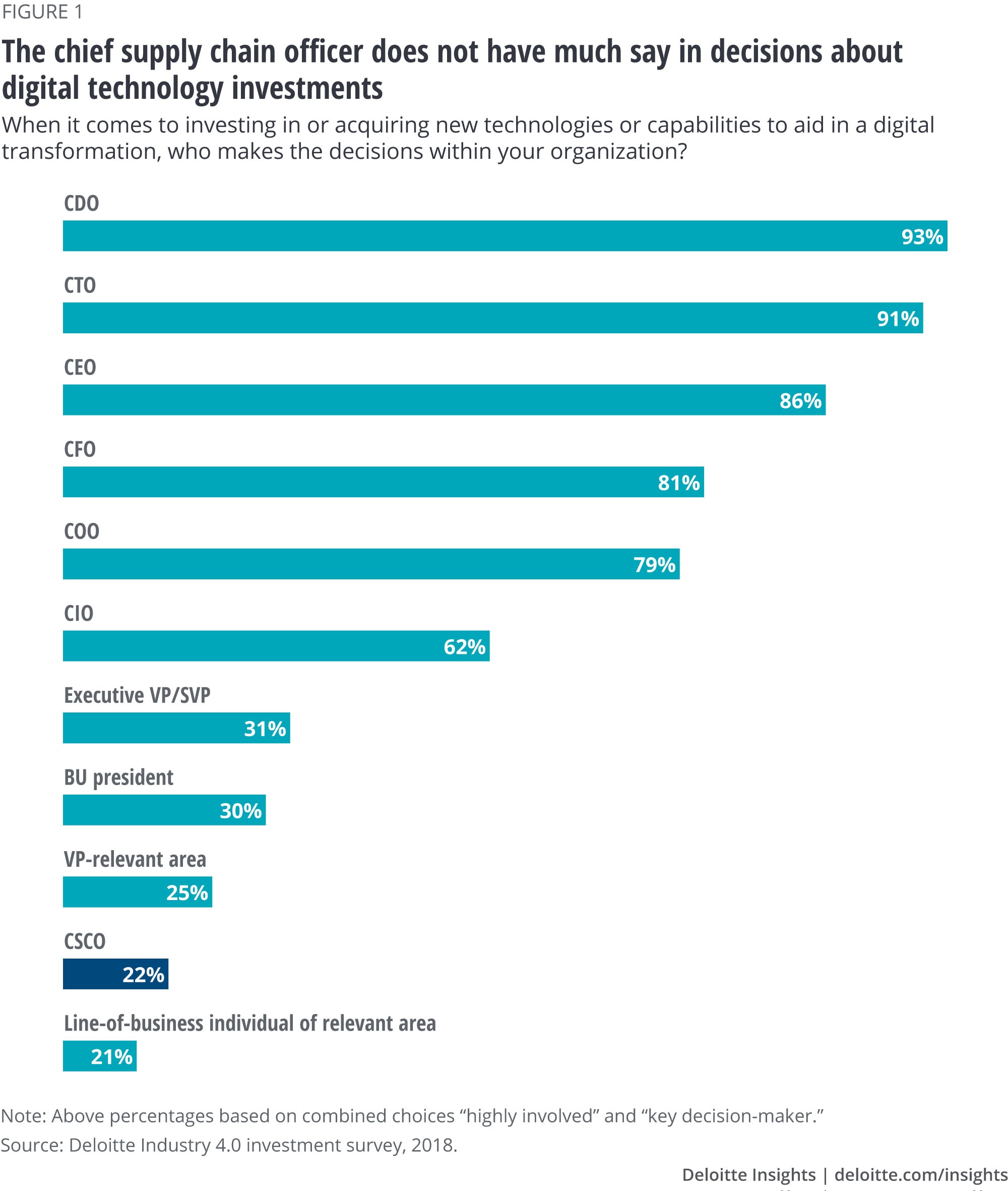
The supply chain paradox High priority, low stakeholder engagement
10 October 2018
Our survey respondents recognize the supply chain’s importance in digital transformation efforts—yet many do not view it as a driver of digital innovation, nor are its leaders involved in strategic decisions.
Long before the digital era that we commonly associate with Industry 4.0, the supply chain has served as the lifeblood of the industrial organization. In recent decades, however, supply chains have grown increasingly global and complex, enabled in large part by advanced digital and physical technologies. These technologies have also allowed the supply chain to evolve into something less linear, more interconnected, and responsive to change. Known as the digital supply network (DSN), this new, networked supply chain has reshaped how stakeholders communicate and transact with each other. The emergence of the DSN allows the supply chain to become a more strategically critical component of the organization—one that enables more informed decision-making and a more flexible, responsive organization.1
Learn More
Explore the Industry 4.0 Paradox report:
Around the physical-digital-physical loop
View the entire Industry 4.0 collection
Subscribe to receive updates on Industry 4.0
However, the question remains whether the reality of the organization has caught up with the new strategic role of the digitally connected supply chain and its potential to drive innovation. On the one hand, our survey results appear to affirm the strategic imperative of investment in the digital supply chain; on the other, results also show that the supply chain is not seen as a particularly strong driver of innovation. Further, our survey results reveal that the chief supply chain officer (CSCO)—the ostensible leader of supply chain strategy and day-to-day operations—typically plays a relatively small role in shaping digital transformation investment decisions.
Thus a striking gap may exist: Organizations may consider the supply chain as relatively important in digital transformation efforts and yet not view it as a driver of digital innovation—nor involve its leaders in strategic decisions.
A striking gap may exist: Organizations may consider the supply chain as relatively important in digital transformation efforts and yet not view it as a driver of digital innovation—nor involve its leaders in strategic decisions.
The role of the supply chain in the digital organization
Our survey results suggest that the supply chain plays an important role in the digital organization (table 1). When asked, “What functions are you prioritizing for future [digital] investment?” the supply chain emerged as the top overall answer, with 62 percent among overall respondents—ahead of planning, product design, and substantially ahead of smart factories. Among just C-suite executives, that gap was even wider.2

Another indication that the supply chain plays an important role in the discussion on digital transformation resides in where most organizations actually have digital transformation efforts underway. In this metric, the supply chain received the highest response among C-suite respondents and third-highest overall (table 2).

The supply chain is not seen as a driver of innovation
Despite its high standing for current and planned deployment of digital transformation capital, the supply chain does not appear to be perceived as a center of innovation (table 3). When asked what functions respondents believe are driving the most digital innovation, supply chain ranked in the middle of the pack at 34 percent—far behind information technology and operations/production. This response is especially surprising given the close functional relationship that exists between the supply chain and operations/production within the overarching manufacturing value chain.
It is also worth noting that, while only 34 percent of overall respondents see the supply chain as a driver of innovation, of the respondents who are prioritizing the supply chain for future digital investment, only a slightly higher 38 percent say the same. One might have expected an even higher share given that this subgroup already places emphasis on the future supply chain digital investment. Further, those that prioritize the supply chain for future digital investment seem just as likely as overall respondents to view operations and production as leading drivers of innovation (59 percent vs. 57 percent, respectively).
So why does this gap exist between the high priority placed on supply chain digital transformation investments and the rather middling status of supply chains as a source of innovation? While most organizations appear to prioritize the supply chain as a critical component of digital transformation initiatives, they may not yet fully appreciate its potential for digital innovation, a finding we explore in greater depth in The innovation paradox. This suggests a missed opportunity, as the advent of the DSN enables innovative opportunities in a broad range of areas.3

The curious case of the CSCO
The increasingly strategic role of the modern supply chain has spawned a new addition to the executive suite. This new role may go by slightly different names, but is often known as the chief supply chain officer (CSCO). The presumed charge of the supply chain leader includes both a tactical oversight of day-to-day supply chain operations, as well as the strategic vision of how the supply chain fits into the larger digital organization.
The presence of the CSCO (or its equivalent) in the senior ranks of the organization has risen commensurately with the growth in advanced, connected technologies. According to one survey, only 8 percent of Fortune 500 companies had a single executive in charge of the entirety of the supply chain in 2004. By 2016, that figure had risen to 68 percent.4
Given this seeming evidence that the supply chain figures prominently in respondents’ digital transformation priorities and activities, it would stand to reason that the CSCO should also figure prominently in any decision to invest in digital transformation technologies. However, the responses suggest otherwise (figure 1).
Only 22 percent of the overall respondents said that the CSCO was either a key decision-maker or highly involved in the decision-making process. In fact, respondents ranked the CSCO lower than any other C-suite officer, and comparable with the lowest among non-C-suite leaders of each business area, at 21 percent. Significantly, supply chain executives themselves also appear to perceive themselves as outside the decision-making process; none of the 15 respondents who identified as a CSCO said that the CSCO was either a key decision-maker or highly involved in the decision-making process.
Only 22 percent of respondents said that the CSCO was either a key decision-maker or highly involved in the decision-making process.

Further, when asked to evaluate their respective personal involvement in digital transformation investment decisions, CSCOs ranked themselves far lower than other C-suite executives did (table 4). Slightly more than 90 percent of C-suite respondents (excluding CSCO respondents) said that they personally were either highly involved or key decision-makers; 37 percent of non-C-suite respondents said the same. However, none of the CSCO respondents responded as such.
CSCOs ranked themselves far lower than other C-suite executives when evaluating their personal involvement in digital transformation. In fact, no CSCOs indicated that they were highly involved in such investment decisions.

The supply chain paradox
Herein lies the supply chain paradox: On the one hand, the supply chain appears to play an important role in future digital investment priorities, and represents a top choice for where respondents have digital deployment initiatives already underway. But on the other hand, the supply chain is not widely perceived as a strong driver of innovation. And the CSCO—the single executive in charge of the entire supply chain—is by far the C-suite executive with the least involvement in the digital acquisition decision, and among the least overall.
So, why does this seeming paradox exist? A few possibilities come to the fore:
- CSCO is a new role. As a relatively new member of the C-suite, the CSCO may not yet have the profile that other, more established roles enjoy—even if the role is increasingly common and supply chain digital investments are a top priority. To this end, some executives, including the CSCO, may not yet understand or otherwise appreciate what the CSCO role is or what its purview should be.
- Supply chain may have an image problem. In the digital era, the supply chain has never been more integrated into the organization’s overall business strategy.5 But image often lags reality, and some in the C-suite may not yet fully accept how the supply chain has evolved in recent years into an area riper for innovation, as the middling status of the supply chain makes clear (table 3). Such an image problem—to the extent it exists—may also make it more difficult for the CSCO to be heard on matters related to the organization’s strategic planning.
- Like CSCO, like non-C-suite. The CSCO does not appear to be perceived as critical to the decision to invest in digital technologies, despite her day-to-day involvement in an area considered key to future digital investments. This may be part of an even larger paradox: Those with presumably the most “touch and feel” involvement with the implementation of digital technologies—i.e., those outside of the C-suite who direct the actual day-to-day business operations—reported being the least involved in making technology investment decisions (table 4).
Elevating the supply chain and shrinking the paradox
Our survey results underscore the importance of the supply chain in future digital investment priorities, but also that the supply chain is not perceived as a strong driver of innovation, and the CSCO gets little say in the matter. Organizations can take several steps to help reconcile this disconnect:
- Validate the increasing strategic importance of the supply chain—and, by extension, those who run it. Our survey suggests that the supply chain figures prominently in the implementation of digital technologies—both now and going forward. The company should say so, unambiguously. And, in so doing, the organization should formally elevate the status of the CSCO and give her—and those outside of the C-suite with day-to-day, touch-and-feel oversight of the implementation and operation of digital technologies—a seat at the decision-making table.
- Train future CSCOs to think strategically. The CSCO focuses on the care and feeding of the supply chain organization. If the company wants a strategic CSCO, it should train its supply chain organization to think strategically. Such action could translate to a supply chain culture in which professionals understand the bigger strategic implications of the decisions they make, and whose goals align with the broader strategic objectives of the organization.
- Leverage the opportunities for digitally driven innovation inherent in a digital supply network. While most organizations prioritize the supply chain as a top area for digital transformation investments, they are far less likely to recognize it as an area for innovation. Yet the DSN opens new opportunities for truly innovative—and transformative—uses of technology to guide end-to-end supply chain transparency, intelligent optimization, and flexible, intelligent decision-making.6 Indeed, such uses extend beyond mere opportunities. In the digital era, they are imperatives.
These and other steps may go a long way in helping an organization diminish the inconsistencies that the supply chain paradox presents and, in so doing, realize so much more from its investment in supply chain connectivity.
© 2021. See Terms of Use for more information.





